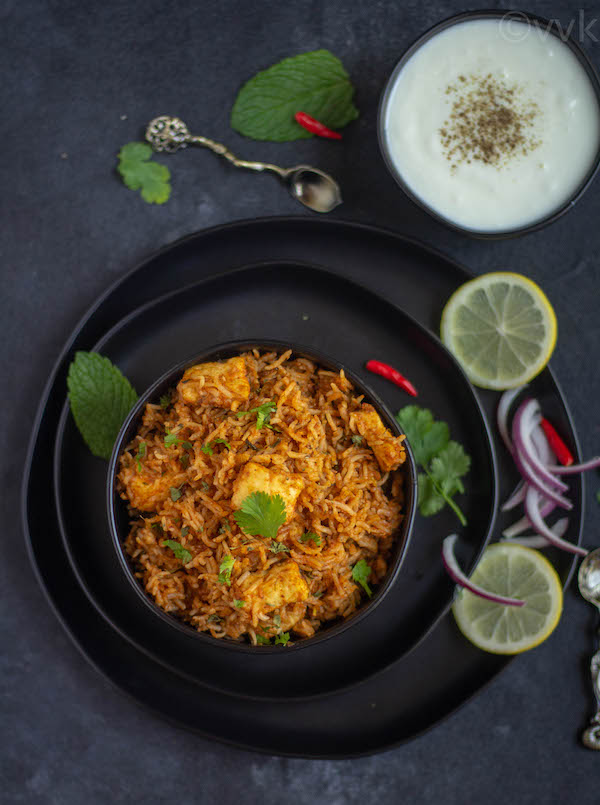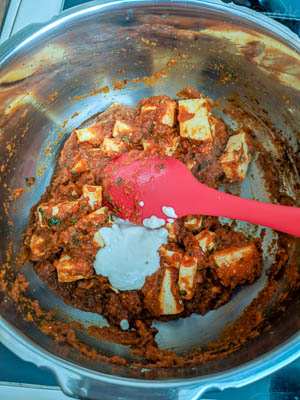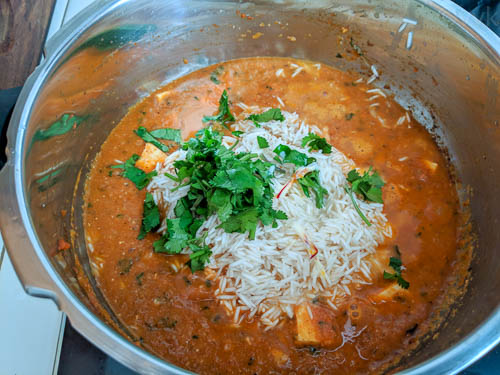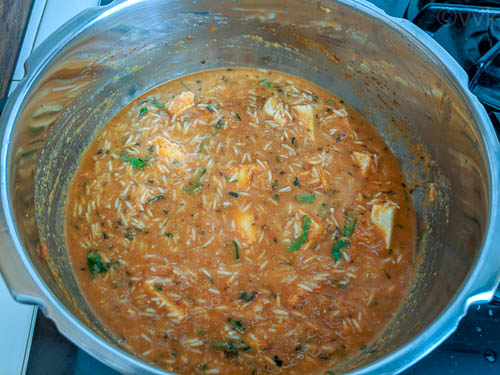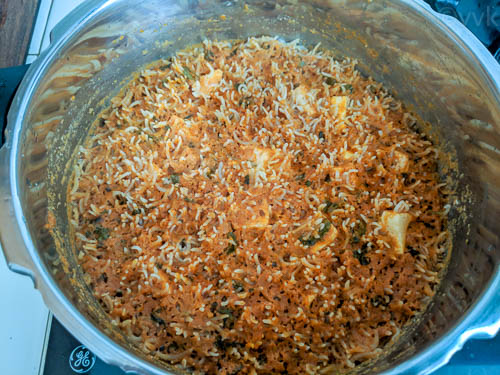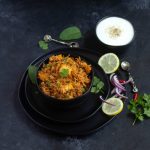P for paneer. Period. When I prepared the list for this biryani, I wrote, “any paneer based biryani” for the letter P. I have already shared cinnamon loaded, pressure cooker paneer biryani during the last marathon. This time I narrowed it down to either paneer tikka biryani or paneer makhani biryani but the family selected paneer makhani biryani. I learned quite a few North Indian dishes from my friends only after coming to the US. I always used to get confused with paneer butter masala and paneer makhani and learned both are the same. But some people make subtle changes and make it differently too. Cooking all about unleashing your creativity. Am I right?
Paneer Makhani Sauce:
You can find an easy-peasy paneer butter masala recipe on my blog, and it is semi-homemade as I used store-bought tomato sauce. But it is very mild and quite easy to make especially during the busy weekdays. I am using the store-bought sauce for this recipe as well. Now that kiddo can handle the heat and spice, for this recipe, I added garam masala and tandoori masala along with red chili powder. Don’t worry; this biryani is still mild. Thanks to the saffron soaked milk and the creamy cashew paste. This biryani is not spicy at all, and everyone including kids can enjoy this paneer makhani biryani. If you don’t want to make biryani, after adding the cashew puree, add ½ cup of water and saffron soaked milk or heavy cream for a rich paneer makhani. Serve it with rice, roti or naan. PS: As the sauce or gravy for this biryani is heavy, the rice might look soft and mushy when hot, but once it cools down, it becomes grainy. I do need to agree, it is not super grainy like the onion biryani, or my cinnamon loaded paneer biryani or any other pressure cooker biryanis. If you want grainy biryani, I would recommend, cooking the gravy separately and the rice separately and then mix them both gently. Now let share how I made paneer makhani biryani in the pressure cooker. Ingredients:
2 tbsp butter 1 tsp cumin seeds One onion pureed approx 1 cup after pureed ½ cup tomato puree, I used store-bought one. 1 tsp ginger-garlic paste 1.5 tsp red chili powder 1 tsp garam masala ½ tsp tandoori masala 2 tsp sugar 1.5 tsp salt 4 tbsp milk, lukewarm Five saffron strands 8 oz paneer, cut into cubes 1 tbsp dried fenugreek leaves, kasoori methi Ten whole cashews. 2 tbsp cilantro, finely chopped 1.25 cup water, divided (1 + ¼ cup) 1 cup basmati rice washed and soaked 20 minutes
Prep-Work:
Wash the rice and soak it in water for 20 minutes and then drain it. Soak the cashews in lukewarm water for atleast 20 to 30 minutes. Drain the water. Then grind into a paste by adding 3 to 4 tbsps of water and set aside. Do not add the entire ¼ cup of water while grinding the cashews. Use the remaining 1 cup of water to rinse the mixer jar and set it aside. Soak the saffron strands in 4 tbsp of lukewarm milk for 20 minutes. Chop the onion roughly and grind into a coarse puree — no need to add water while grinding the onion.
Steps:
Heat the pressure cooker and melt the butter. Then add the cumin seeds, onion paste, and the ginger-garlic paste.
Cook until the raw smell goes off. It took me about 8 minutes.
Next add the tomato puree, red chili powder, garam masala, tandoori masala, sugar, and salt — Cook for 3 to 4 minutes.
Then add the chopped paneer and kasoori methi. Mix well.
Now add the cashew puree.
Followed by 1 cup of the reserved water used for rinsing the mixer jar and the rice, cilantro and saffron milk.
Mix gently.
Close the pressure cooker lid and put the weight on. Cook for one whistle and after one whistle, reduce the heat to low(on a number scale it is 2) and cook for 5 minutes. Then turn off the heat. Allow the pressure to release naturally. After opening the pressure cooker lid, allow the rice to cool for 5 minutes.
Then fluff it with a fork and serve warm with raita.
Recipe Notes-
You can use regular tomatoes instead of the store-bought puree. In that case, grind two medium-sized tomatoes separately. Adjust the salt and spice according to your preference. As the sauce is heavy and as we are adding milk and cashew puree, 1 cup of water is sufficient for this biryani. You need approx 1 ⅓ cup of water for 1 cup of rice. You can split and adjust the water&milk according to your preference. Instead of milk, you can use heavy cream too. You can turn off the heat after one whistle, but I allowed it to cook for five more minutes for the biryani to absorb all the heavy sauces. It acts as a DUM as well. If you want grainy biryani, I would recommend, cooking the gravy separately and the rice separately and then mix them both gently.
📖 Recipe

